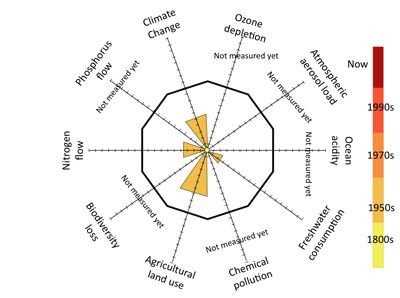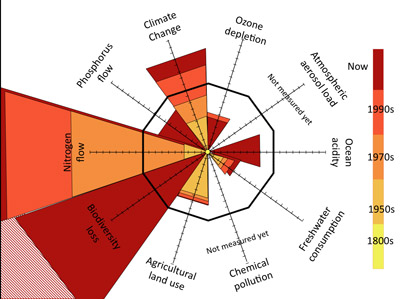The Mind and Life XXIII meeting on ‟Ecology, Ethics, and Interdependence” recently took place in Dharamsala, India, with His Holiness the Dalai Lama and a host of eminent scientists and thinkers. (These meetings can be seen on Youtube, or on www.dalailama.com, and www.mindandlife.org)
Professor Diana Liverman from the University of Arizona was the first speaker. She gave an impressive explanation of the acceleration of some of the factors (i.e. human population, water use, damming of rivers, use of fertilizers, paper consumption, number of vehicles, and so on) that have occurred since the 1950s and that now defines a new era for our planet. This era is called the anthropocene era, (literally the era of humans). It is an era during which, for the first time in history, human activities deeply modify (and at this time degrade) the global system that sustains life on our planet.
Professor Liverman also explained the concept of ‟planetary boundaries.” She defined nine planetary boundaries that, when crossed, can have destructive and even catastrophic effects on the planet. The nine boundaries concern climate change, biodiversity loss, nitrogen in the atmosphere and phosphorous in the oceans, stratospheric ozone depletion, ocean acidification, global fresh water use, changes in land use, atmosphere aerosol loading, and chemical pollution.
These factors need to be kept within certain boundaries in order to keep a safe distance from a threshold beyond which there could be a point of no return, and to give us time to change our course of action in order to lessen the degradation. As illustrated by the two diagrams shown below, in 1950 all the measured factors were still well within safe limits.


Today three major factors – climate change, biodiversity loss, and nitrogen flow – have crossed the safety boundaries and all the others are fast approaching their boundaries too. (A safety zone can be compared to the distance at which a car approaching a cliff that is somewhere ahead in the road, should slow down to avoid falling over into the abyss.) For most of these factors, scientists still do not know exactly when the damage will be irreversible once the safety zone is crossed.
It is already almost past the crucial time for all of us to finally realize the immense benefits of harnessing the best of human creativity and develop alternative technologies, apply simple ways to minimize our footprint on the planet, and cultivate a life of voluntary simplicity rather than continue free rein consumerism.